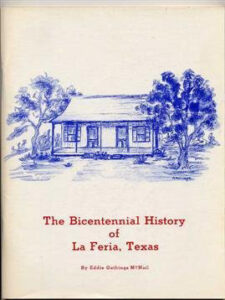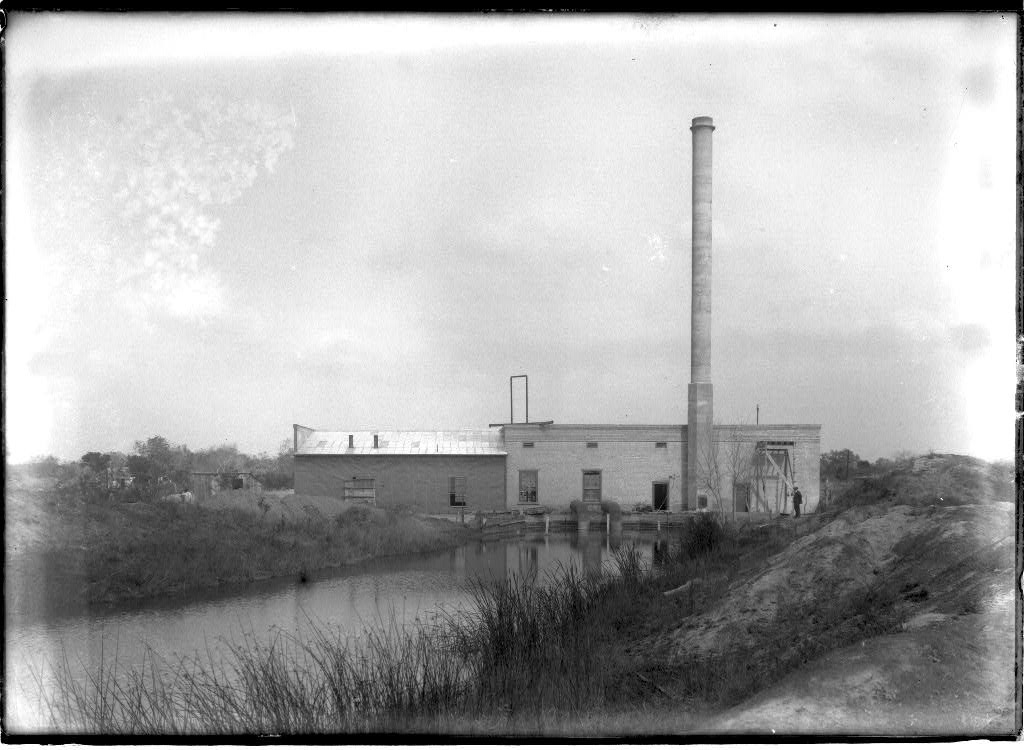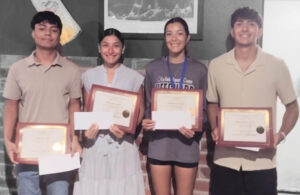- Scholarship Awards
- La Feria ISD is Set to Get Its Own Police Department
- All-Star Regionals
- LFECHS Non-Varsity Band Represents at State
- School Program Continues to Provide Fun Summer Activities
- Conservation Group Wildlife in Focus Expands Unique Photography Contest to Reach More Landowners, Photographers Statewide
- Local Birding Center Offers a Variety of Events
- Valley Native is Heading to the Olympics
- Hurricane Preparedness For Families
- Golf Tournament to be Held toHelp Cancer Patients
The La Feria Mutual Canal Company and the La Feria Water Control and Improvement District
- Updated: September 11, 2015

The city of La Feria is celebrating its 100th year anniversary and to commemorate the occasion we are digging deep into our archives each week to bring you images and stories from La Feria’s colorful past.
 |
The following story is a chapter from a manuscript entitled The Bicentennial History of La Feria, Texas written by Eddie Gathings McNail in 1975. Throughout the coming year we’ll be reprinting sections of her research into the history of La Feria as the city celebrates its 100 year anniversary. |
The very existence of La Feria and the surrounding community depended upon water and a system of irrigation. Jose de Escandon, a promoter and land developer, after making a home for himself in Mexico, crossedthe Rio Grande River and brought settlers into the Rio Grande Valley in 1749. It was he who developed a system of irrigation during his nine years of colonization.
However, Stephen F. Austin, the Father of Texas, as he traveled to Mexico City by way of Matamoros in April, 1833 described this section as “the poorest I ever saw in my life.” He said that the country was a pile of sand hills with nothing in the way of vegetation but cactus, sagebrush and mesquite covered land.
Men with foresight, such as S. J. Schnorenberg, who was connected with the Minnesota-Texas Land and Irrigation Company, realized the possibilities existing here. The La Feria Mutual Canal Company was founded in 1909 with a capital stock of $253,320.00. There was both Preferred and Common Stock, with C. S. Towne and J. J. Schradle owning fifty-six and 77/100 shares of common stock.
S. J. Schnorenberg was the president; J. S. Docks, the surveyor and civil engineer; 0. E. Walker, the secretary; and J. A. Cord, the bookkeeper.
There was one steam pump on the river at the present location and an elevated flume cross the Arroyo Colorado to provide necessary water for farm land. One of the essential expenditures from 1910 to 1915 was the buying and feeding of mules to do construction work.

The La Feria pumping plant, February 2, 1920. Photo: Robert Runyon Photograph Collection/The Center for American History and General Libraries, University of Texas at Austin
An important event recorded in Book 1, on page 394 of a ledger in the water office, was the first freight train sided at the station of La Feria and set out two cars* on October 29, 1910.
Men worked for 10$ per hour for ten hours; the foreman received 30C per hour; a team of mules or horses got 35C per hour.
The ditch riders in 1910 were: R. G. Hall, Paul Ayres, Clarence Jeffords and G. Rose.
The Rio Grande Hardware Company was housed next to the old bank building on Main Street and sold pumps and machinery to the La Feria Mutual Canal Company. The South Texas Lumber Company was in business selling lumber, nails, posts, poles, locks, chains, etc., for gates, bridges and other purposes.
On March 6, 1911, E. W. Anglin was paid $747.26 for completing Dr. Wilson’s main lateral. The La Feria Sugar Company was in operation in September, 1911, because the company bought 50 cords of wood at $1.25 per cord and used much water during this time.
For building the settling basin and raising the reservoir banks in 1911, Charles C. Vann received $404.00 in payment. He, also, worked at the Wilson Tract, for much construction on canals and lateral was necessary.
The Military Highway, once known as Camino Real, which was a dirt road winding along the river, was at one time the bank of the mighty Rio Grande River that gradually moved south.
Since land was being cleared, there was much wood to be sold.
John Moet, who was a contractor for clearing land, sold many cords of wood to the Canal Company, the local schools and individuals. His work force was comprised mostly of “wet backs” who crossed the Rio Grande River from Mexico looking for higher wages and steady work.
On September 27, 1915, an outpost of American soldiers was fired upon at the La Feria pumping plant on the river, but no casualties resulted.
In 1917, the name was changed to the La Feria Water Control and Improvement District and was housed in the Cameron County Bank building on Main Street. The chairman of the Board was George H. Byrnes; the secretary, C. P. Brown,.and the Board members: E. C. Morrison, W. A. Bailey and J. J, Heidt.
On June 27, 1918, a new pump site was selected at the river, south of Bluetown, That same year a diesel engine was bought for the pump. A four-room frame house was built for the engineer at a cost of $752.60 in 1919.
A small frame building north of the railroad tracks was used as an office until 1922 when the contract was let to O. E. Van Berg, president of the Hidalgo County Bank and Trust Company of Mercedes, to build a two-story building at a cost of $7,380.00 on the same site. Arthur P. Lippott was president and Moore Matthews, secretary. This building served a useful purpose for some forty-four years.
Perhaps the man who worked untiringly,.and _most diligently for the Water District was A.. W. Amthor. He became the permanent engineer in July, 1918 at a salary of $200.00 per month. He continued to work from 1918 until September, 1947 during which time he served as manager twice as well as engineer.
A statement of the financial condition of the La Feria Water and Improvement District on January 22, 1926 showed the total assets at $1,160,661.13. The profit for the period’- September 1, 1925 to January 22, 1926 was $12,852.39.
The actual metes and bounds were worked up in 1958 to secure a government loan for rehabilitation. The resolution was as follows:
On December 7, 1959, the La Feria Water Control and Improvement District, Cameron County Number Three, entered into a contract with the United States of America for the rehabilitation of the facilities in the total amount of $5,750,000.00.
The Board of Directors desires to complete said rehabilitation and does hereby respectfully request the Bureau of Reclamation to include an appropriation of $91,000.00 in the Bureau of Budgets recommendation for the fiscal year beginning July 1, 1971, on said contract between the District and the United States of America, it being understood by the Board of Directors that any cost of said items above-listed above the sum of $91,000.00 would be born by said District.
General Manager H. B. Combs was authorized to proceed with the rehabilitation project.
The present building housing the La Feria Water Control and Improvement District/ including the office and shop buildings, cost $77,476.00 in 1965. The plaque at the front entrance contains the following information:
La Feria Water Control and Improvement District, Cameron County, Number Three
R. M. King, President
Jack O’Rear, Vice President
G. D. Shimek, Secretary
E. J. Wolf
J. H. Eubanks
R. T. Hensley, Manager
Charles B. Croft, A.I.A., Architect
Eddleblute Construe. Co., Contractor 1965
The managers and sometimes presidents as well, are:
H. M. Miller, 1910-1911
S. J. Schnorenberg, 1911-1912
F. A. Schaff, 1912-1913
Elbert Yates, 1913-1914
R. H. Johnson, 1914-1915
George H. Byrnes, 1917-1918
J. V. Reid, 1918-1919
I. Burgoon, 1919-1920
Arthur P. Lippott, 1920-1923
A. W. Amthor, 1921-1923
W. W. Houser, 1924-1926
A. W. Amthor, 1926-1937
Moore Matthews, 1937-1948
W. D. Cooper, 1948-1950
Emory B. Worley, 1950-1959
Robert T. Hensley, 1959-1967
In 1975, Harold B. Combs is the General Manager of the La Feria Water District, having been employed in 1967. The office force consists of: Mrs. L. P. Joyce, clerk; Mrs. R. M. Cherrington, Tax Assessor-Collector; Mrs. Harold Lievens, bookkeeper; Max Maples, water master and assistant manager; Robert Jiminez who runs the second lift pump under the direction of Max Maples; A. C. Herren, Jr., Edward L. Patterson and Ruben Aulds, canal supervisors; and Guadalupe Jaramilla, shop foreman. Harla Cox, engineer, retired in July, 1973; Tom Ashworth, in August, 1974; and Mike Hampton resigned in April, 1975.
The citizens and farmers of La Feria pay tribute to an organization that has functioned successfully and ably over sixty-six years, with service, courtesy and efficiency.
Do YOU have any photos, books, or stories that might help us piece together La Feria’s storied history? If so please email us or call our office at 956-797-9920 and let us know!


